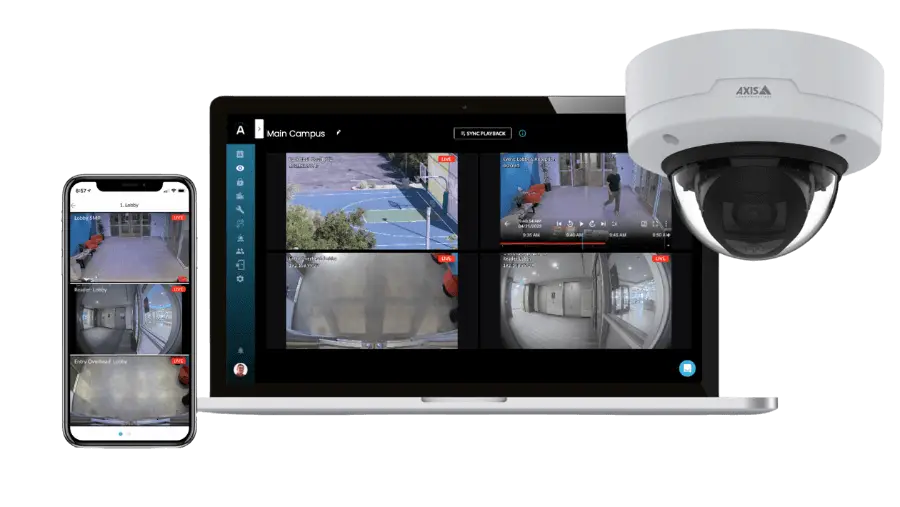Ah, video security. It provides irrefutable visual proof of a series of events or actions. It can identify suspects, victims, vehicles, and determine the cause and/or responsibility for a crime or an accident. Live monitoring speeds emergency response to any incident. Security system recordings provide undeniable evidence for authorities.
Remote video surveillance puts eyes on multiple places simultaneously for dramatically less than the cost of a manned guard presence. Look to the entrances, ceilings, stairwells, and hallways in schools, hospitals, retail stores, factories, and commercial spaces – even the light poles in parking lots – and you’re likely to see a 360° security camera like this one capturing your every move. But have we gone too far? Businesses using traditional video surveillance technology are generating millions of hours of footage that can get expensive to archive locally and be overwhelming to search. Those that moved security cameras to a cloud infrastructure require a constant internet connection and consume huge amounts of network bandwidth.
This article will discuss the importance of implementing a modernized, scalable, and reliable cloud based security solution that overcomes the shortcomings of both traditional and pure cloud surveillance systems. This Hybrid Cloud Security uses a combination of onboard camera storage and cloud-based data storage with a software-first approach.
The Trouble with Traditional Tech
For the last 20 years or so, video surveillance has been dominated by two technologies: Network Video Recorders (NVR) and Digital Video Recorders (DVR). Both are used for on-premises storage of business security video, but there are some key differences between them.
NVR systems use high quality IP (internet protocol) cameras to capture and process video data and then stream it to the NVR recorder for storage on a hard disk, a big improvement over tape storage. An IP camera is wireless, which provides some scalability and flexibility in setup, but multiple live high resolution video feeds consume a lot of network bandwidth. Remote viewing is possible as the system is connected to the internet. For the same reason, NVR systems are subject to service outages; no signal, no video, resulting in gaps in coverage.
DVRs are used with hardwired analog or some digital cameras, making installation labor intensive while limiting scalability. The technology is older and doesn’t support as many features as NVR systems, but is less expensive. DVRs process video streams at the recorder and store data on a hard disk, and all monitoring/viewing must occur at the device; there is no remote access to surveillance footage. DVRs are best for businesses where all security monitoring is performed at a single location. Still, reliability is better than NVR systems as there are no wireless network components that can be impacted by a service outage.
However, both technologies present similar limitations in storage capacity, possible camera compatibility issues, and challenges to scalability at growing businesses as they exceed the number of cameras and locations their NVR/DVR can support. Then there are all the software updates and security patches that must be manually installed on all on-premises devices, adding to the IT maintenance burden.
Pure Cloud Surveillance? Not So Fast
It seems like there is a cloud-based alternative for just about everything these days, and video surveillance is no different. There are many providers of cloud video storage that offer to install their proprietary IP cameras on site and store all video surveillance footage in the cloud for remote viewing from anywhere.
Pure cloud camera systems eliminate the need for on-premises hardware; they wirelessly transmit all data to the cloud. One of the attractions to video surveillance as a service (VSaaS) is that customers only pay for the data consumed. The provider is responsible for all hardware failures and software updates. The issue here is that pure cloud cameras have no memory and require a consistent high bandwidth internet connection to continuously stream video and protect sensitive data from what could be dozens of cameras to the cloud in real time. That consumes huge amounts of data, making the subscription model deceptively expensive (while still leaving the business exposed to gaps in coverage in the event of a service outage).

Hybrid Cloud Video Security Systems: The Perfect Middle Ground
Hybrid cloud storage systems combine the best of on-premises video hardware with a hybrid cloud environment. It solves the storage capacity problems, coverage gaps, and scalability limitations of traditional tech while enabling several advanced capabilities to control costs.
Hybrid cloud systems easily adapt to the changing needs of businesses by doing away with on-prem recording devices and eliminating data storage and camera limits. Video can be viewed on any browser or device connected to the internet from any location. An unlimited number of cameras can be connected to the cloud for a totally flexible and scalable solution.
To overcome the issue of internet service outages and coverage gaps, hybrid cloud systems use wireless IP cameras equipped with solid-state drives (SSD) to store data at the device. This removes any single point of failure and ensures there is always an uninterrupted record of events available for upload after a connectivity issue has been resolved.
To address data consumption and spiraling cost concerns, hybrid cloud cameras can be programmed to upload only select metadata and motion- or activity-triggered footage rather than a continuous stream of live video, dramatically decreasing bandwidth and data storage requirements. Cloud users can adjust video retention time, resolution, and other features to limit data consumption.
Most hybrid cloud cameras can be installed with a simple Power over Ethernet (PoE) connection, allowing units to be placed anywhere there is power and an internet signal. Service and support are simplified by deploying fleet-wide firmware and software updates automatically through the cloud, reducing maintenance requirements.
The hybrid cloud environment model is the new standard in video surveillance. It is a cost-effective, bandwidth-friendly solution for security-conscious businesses that need many cameras operating on the same network to achieve 100% visibility of their property or environment. But like everything else in your hybrid cloud architecture, you need the right provider. You need Arcules.
Arcules Redefines Hybrid Cloud Video Security
The world’s only truly open cloud-based video management system, the Arcules VSaaS platform easily integrates with all a business’ existing security functions, infrastructure, and workflows. Arcules is built to manage video surveillance on a massive scale, covering multiple physical locations using an unlimited number of cameras with the highest levels of control and agility.
Unlike competitive cloud-based surveillance solutions that require a major upfront investment to remove existing cameras and replace them with proprietary hardware, Arcules saves time and money by seamlessly integrating with existing cameras, eliminating switching costs and ensuring a smooth transition from legacy systems. Arcules eliminates the need to purchase new video equipment as it supports more than 6,000 types of ONVIF-compliant IP cameras, access control panels, and sensors, maximizing every businesses’ investment in existing video surveillance technology.
With your cameras feeding video data to the Arcules cloud you’ll be able to monitor all your sites from anywhere on any device using a centralized web portal, and manage video data with access to advanced capabilities including:
- Live and recorded remote video monitoring, with secure cloud-based scalable data storage
- Forensic video search tools with intuitive AI-powered analytics to comb through hours of footage for highly relevant search results in seconds
- Support for advanced video surveillance features such as thermal imaging, night vision, occupancy counting, facial recognition, and more
- Integration with access control systems to verify and cross-check physical activity
- Push notifications to alert personnel for immediate threat response
- Control over bandwidth and data storage parameters to limit data consumption

With Arcules, software upgrades are automatic and proactive support alerts users to potential issues before they become problems. The Arcules VSaaS subscription model reduces risk and complexity, with several flexible plan options to meet any businesses’ unique needs and budget. Leave the limitations of NVRs and DVRs behind, and move to a hybrid cloud video security solution that puts you in control.
To learn more about how hybrid cloud video surveillance systems can enhance the security of your business, visit the Arcules Cloud Surveillance Solutions page and schedule your FREE consultation.

